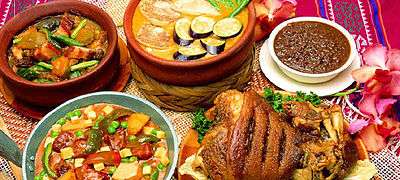Camaron rebosado
Camaron rebosado is a deep-fried battered shrimp dish in Philippine cuisine. It is usually served with a sweet and sour sauce. It is a common dish in Philippine cuisine.[2]
 | |
| Alternative names | rebosadong hipon[1] |
|---|---|
| Course | Main dish |
| Place of origin | Philippines |
| Serving temperature | Hot |
| Main ingredients | shrimp, batter |
| Variations | Camaron rebosado con jamon |
Etymology
The term camaron rebosado comes from Spanish camarón ("shrimp"); and rebosar (originally "bubble over, overflow", but meaning "battered" in Tagalog).[3] Despite the Spanish name, the dish is Chinese Filipino, originally introduced by Chinese migrants to the Philippines.[2][4]
Preparation
Camaron rebosado is prepared by removing the heads, and sometimes the tails as well, of the shrimp.[5] It is then sliced lengthwise along the back and butterflied, with the vein removed.[6][7] The shrimp is then marinated for a few minutes in a mixture of calamansi juice, salt, black pepper, garlic, and other spices to taste. The batter is made by mixing flour with egg, black pepper, corn starch or baking powder, and water.[7][8][6][4] The shrimp is coated evenly and then fried in hot oil.[7][8] It is also common to coat the shrimp in bread crumbs before frying.[9][10]
Camaron rebosado is traditionally served with sweet and sour sauce (agre dulce).[9][11] The sauce may be poured atop the cooked shrimp or served as a dipping sauce.[12] It can also be served with soy sauce and calamansi juice (toyomansi), garlic-infused mayonnaise, or tomato and banana ketchup.[13][2][8]
Camaron rebosado is similar to Japanese tempura, although tempura uses a lighter batter that is chilled before frying.[14][13]
Variations
Camaron rebosado con jamon (also spelled camaron rebosado con hamon) is a variation of the dish that includes ham wrapped around the shrimp in its preparation.[15][16] It is a traditional dish in the Binondo district of Manila, the city's Chinatown.[17]
See also
References
- "Camaron Rebosado". Mama's Guide Recipes. Retrieved 16 December 2018.
- Garcia, M.; Tettoni, L. (2012). Filipino Cookbook: 85 Homestyle Recipes to Delight Your Family and Friends. Tuttle Publishing. p. pt86-88. ISBN 978-1-4629-0528-7.
- Polistico, Edgie (2017). Philippine Food, Cooking, & Dining Dictionary. Anvil Publishing, Incorporated. ISBN 9786214200870.
- Diego, A. (2011). Step by Step Cooking Filipino: Delightful Ideas for Everyday Meals. Step-by-step cooking. Marshall Cavendish International (Asia) Private Limited. p. 82. ISBN 978-981-4435-15-4.
- Basbas, E.A. Learning & Living in the 21st Century i for H.s.' 2007 Ed. Rex Bookstore, Inc. p. 151. ISBN 978-971-23-4784-9.
- Alcuaz, N.T. (2005). Banana Leaves: Filipino Cooking and Much More. Trafford Publishing. p. pt124. ISBN 978-1-4120-5378-5.
- "Camaron Rebosado". Kawaling Pinoy. Retrieved 16 December 2018.
- Agbanog, Liza. "Camaron Rebosado (Deep Fried Battered Prawns)". Salu Salo Recipes. Retrieved 16 December 2018.
- Dagoon, E.A. Culinary Arts i. Rex Bookstore, Inc. p. 141. ISBN 978-971-23-2603-5.
- Fernando, E.A. New Perspectives in English One' 2005 Ed. Rex Bookstore, Inc. p. 127. ISBN 978-971-23-4249-3.
- Alejandro, R.; Tettoni, L. (2012). Authentic Recipes from the Philippines. Tuttle Publishing. p. pt64. ISBN 978-1-4629-0533-1.
- Olizon-Chikiamco, N. (2003). Homestyle Filipino Cooking. Periplus mini cookbooks. Tuttle Publishing. p. pt54. ISBN 978-1-4629-1392-3.
- Alejandro, R.G. (1985). The Philippine Cookbook. A Perigee book. Putnam. p. 30. ISBN 978-0-399-51144-8.
- Fernandez, Doreen; Edilberto N. Alegre (1988). Sarap: Essays on Philippine food. Mr. & Ms. Publishing. p. 145. ISBN 978-971-91137-0-6.
- Panlilio, E.E. (2003). Comfort Food. Anvil Pub. p. 214. ISBN 978-971-27-1407-8.
- Reyes, C.; Fernando, G.C. (1991). Kusina: what's cooking in the Philippines. Kusina: What's Cooking in the Philippines. Larawan Books. p. 165.
- Perez, Irene C. (February 16, 2012). "Camaron Rebosado con Jamon and other 'mestizong Intsik' favorites". Philippine Daily Inquirer. Retrieved April 7, 2016.


